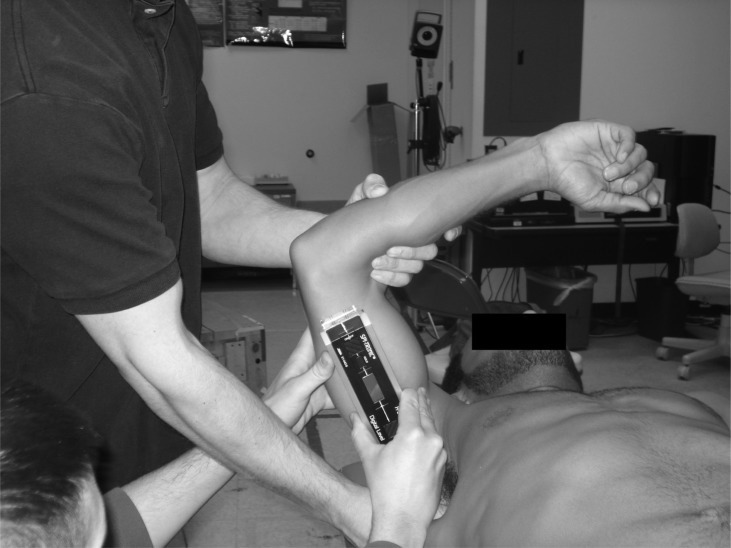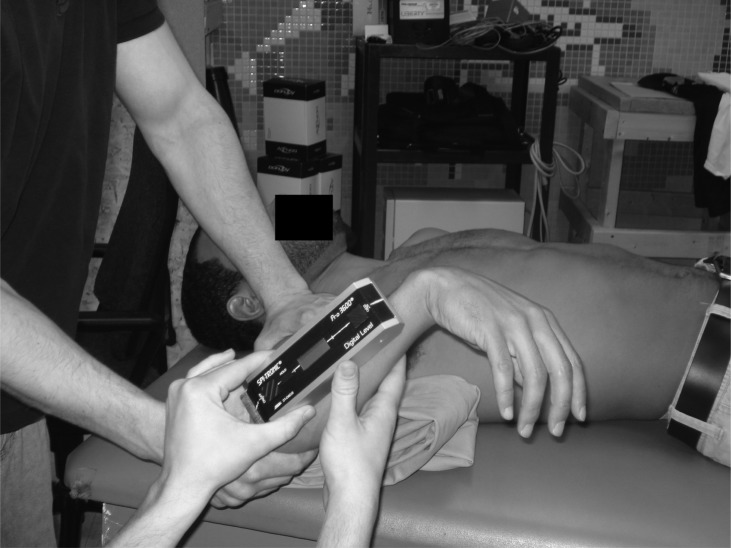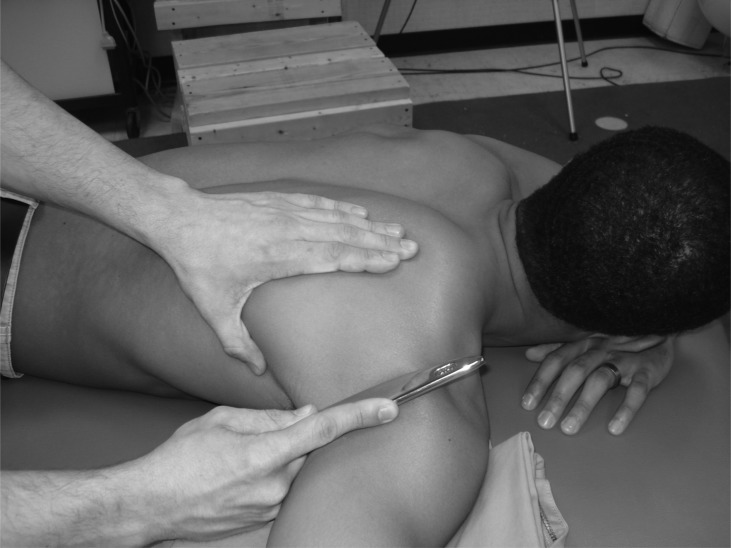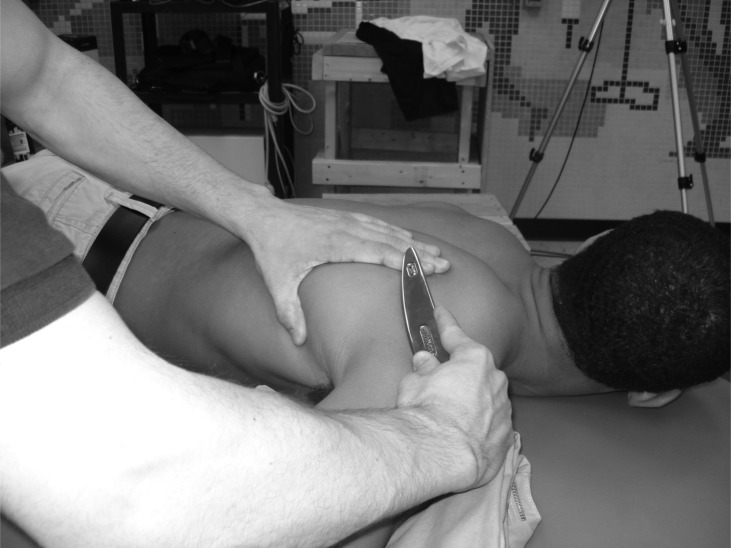Abstract
Background:
Due to the repetitive rotational and distractive forces exerted onto the posterior shoulder during the deceleration phase of the overhead throwing motion, limited glenohumeral (GH) range of motion (ROM) is a common trait found among baseball players, making them prone to a wide variety of shoulder injuries. Although utilization of instrument‐assisted soft tissue mobilization (IASTM), such as the Graston® Technique, has proven effective for various injuries and disorders, there is currently no empirical data regarding the effectiveness of this treatment on posterior shoulder tightness.
Purpose:
To determine the effectiveness of IASTM in improving acute passive GH horizontal adduction and internal rotation ROM in collegiate baseball players.
Methods:
Thirty‐five asymptomatic collegiate baseball players were randomly assigned to one of two groups. Seventeen participants received one application of IASTM to the posterior shoulder in between pretest and posttest measurements of passive GH horizontal adduction and internal rotation ROM. The remaining 18 participants did not receive a treatment intervention between tests, serving as the controls. Data were analyzed using separate 2× 2 mixed‐model analysis of variance, with treatment group as the between‐subjects variable and time as the within‐subjects variable.
Results:
A significant group‐by‐time interaction was present for GH horizontal adduction ROM with the IASTM group showing greater improvements in ROM (11.1°) compared to the control group (‐0.12°) (p <0.001). A significant group‐by‐time interaction was also present for GH internal rotation ROM with the IASTM group having greater improvements (4.8°) compared to the control group (‐0.14°) (p < 0.001).
Conclusions:
The results of this study indicate that an application of IASTM to the posterior shoulder provides acute improvements in both GH horizontal adduction ROM and internal rotation ROM among baseball players.
Level of Evidence:
2b
Keywords: Manual therapy, rehabilitation, shoulder, throwing athlete
Introduction
The overhead throwing motion creates large rotational and distractive forces on the shoulder complex that, over time, may result in changes in the bony and soft tissue structures of the shoulder and can ultimately lead to injury.1‐3 More specifically, researchers have reported that over time, baseball players develop increased glenohumeral (GH) external rotation range of motion (ROM), decreased internal rotation ROM, and decreased horizontal adduction ROM in their throwing arm.3‐5 This change can be the result of both bony3,6,7 and soft tissue4,8 adaptations in the shoulder.
Baseball players are prone to a wide variety of shoulder injuries due to repeated tensile overload placed on the posterior shoulder structures as well as the potential for ensuing tightness of these structures.1,9 Because of the frequent occurrence of injury and associated posterior shoulder tightness, which is often experienced as decreased GH horizontal adduction and internal rotation ROM in the throwing shoulder of baseball players, researchers have examined the effects of various stretching techniques for improving GH horizontal adduction ROM and internal rotation ROM.10‐13 However, these stretching techniques have resulted in variable outcomes adding to the confusion regarding optimal techniques for improving GH ROM. Furthermore, no research has examined the effectiveness of instrument assisted soft tissue mobilization (IASTM) for treating these restrictions.
Graston® Technique (GT) is a form of IASTM that utilizes metal tools to localize and treat soft tissue restrictions. The utilization of GT has been reported to produce a localized inflammatory response, reduce scar tissue, and break down existing scar tissue in people with soft tissue restrictions.14,15 Although there are studies demonstrating the effectiveness of IASTM when applied to acute and chronic injuries,16,17 there are currently no empirical data regarding the effects of IASTM on GH ROM, as well as on any asymptomatic subjects. Therefore, the purpose of this study was to determine the effectiveness of IASTM in improving acute passive GH horizontal adduction and internal rotation ROM in collegiate baseball players.
The authors hypothesized that participants who received an application of IASTM would experience an acute increase in passive GH horizontal adduction ROM and internal rotation ROM as compared to a control group.
Methods
To assess the effectiveness of IASTM on GH ROM, 35 collegiate baseball players (Table 1) volunteered to participate. Inclusion criteria included being a member of a National Collegiate Athletic Association (NCAA) Division I baseball team and having no recent history (within the past 6 months) of upper extremity injuries or any previous upper extremity surgeries in their throwing arm. ROM restrictions were not required to participate. These participants were randomly divided into two groups, one group received the IASTM treatment, and the other group did not receive the treatment intervention, serving as the control group.
Table 1.
Participant characteristics*
| Group | Age (Years) | Height (cm) | Mass (kg) |
|---|---|---|---|
| ISTM (n = 17) | 20.1 ± 1.2 | 189.3 ± 11.2 | 94.1 ± 22.2 |
| Control (n = 18) | 20.3 ± 1.1 | 185.7 ± 5.3 | 85.4 ± 21.2 |
Abbreviations: ISTM, Instrumented soft tissue mobilization.
Values are mean ± standard deviation
The Pro 3600 Digital Inclinometer (SPI‐Tronic, Garden Grove, CA) was used to measure passive GH internal rotation ROM and horizontal adduction ROM. This device provides real‐time digital reading of angles with respect to either a horizontal or vertical reference. This device is accurate up to 0.1° as reported by the manufacturer. The digital inclinometer was modified using a reference line positioned along the midline of the device, which was used for proper alignment of anatomical landmarks.
Graston® Technique was used for the application of IASTM. This technique is performed using six stainless steel tools of varying sizes, shapes, and styles of treatment edges. The differences in the tools allow for the treatment of various anatomical structures with varying intensities.
This study utilized a blinded, randomized design, in which participants were assigned to either an experimental (IASTM) or control group. All participants in this study attended one testing session in their respective athletic training room. Prior to participation, all participants signed an informed consent form approved by the university institutional review board.
Passive GH horizontal adduction and internal rotation ROM of the dominant arm were measured with the participant’s shirt on and in a pretest posttest fashion. Once the pretest measurements were obtained, the experimental group participants immediately removed their shirts and rolled over into a prone position, during which time the two investigators who measured the GH passive ROM left the room. At this time a third investigator applied the IASTM. At the conclusion of the treatment, the participants immediately rolled back over to the original supine position and put their shirt back on to hide any erythema that may have been caused by the IASTM treatment. The investigators who measured the pretest passive GH ROM then re‐entered the room and re‐measured the participants’ GH horizontal adduction ROM and internal rotation ROM. The procedures and passive ROM measurements in the control group were taken using identical methods as those in the experimental group, but this group did not receive any intervention. However, the control group did lie in a prone position for the same amount of time that the experimental group did during their intervention. The total time between pre‐test and posttest measurements for both groups was approximately 90 seconds.
To assess passive GH horizontal adduction ROM, all participants were positioned supine on a standard treatment table. One investigator stood at the side of the table, just inferior to the participant’s dominant arm, and placed the test arm in a position of 90° of shoulder abduction, 90° of elbow flexion, and in neutral rotation. At this point, the same investigator stabilized the lateral border of the scapula and applied a posterior force toward the table to minimize accessory scapular motion. While applying a posterior force to the scapula, the investigator used his opposite hand to grasp just distal to the participant’s elbow joint and passively moved the participant’s arm across his body moving the GH into horizontal adduction until the first point of resistance was felt by the investigator. Once the end ROM was achieved, a second investigator, also standing just inferior to the participant’s dominant arm, used the digital inclinometer to measure the participant’s available amount of passive GH horizontal adduction ROM. The second investigator aligned the digital inclinometer with the ventral shaft of the humerus, and the angle was created using this axis and a line perpendicular with the examination table (Figure 1). This angle was recorded as the total amount of passive GH horizontal adduction ROM. A single measurement for passive GH horizontal adduction ROM was obtained during both the pretest and posttest measurements.
Figure 1.
Glenohumeral horizontal adduction range of motion measurement.
To assess passive GH internal rotation ROM, all participants were positioned supine on the table. One investigator stood at the side of the examination table, just superior to the participant’s dominant arm, and placed this arm in a position of 90° of shoulder abduction, 90° of elbow flexion, and in a neutral rotation. The investigator placed a towel under the participant’s humerus to ensure that it remained level with the acromion process. With one hand, the investigator grasped just distal to the participant’s elbow joint to ensure that the humerus was in a neutral position; with the other hand, the investigator applied a posterior force to the acromion process to stabilize the scapula. The investigator then passively internally rotated the humerus until the end ROM was achieved. At this point, a second investigator used the digital inclinometer to measure the participant’s available amount of passive internal rotation ROM. The second investigator aligned the digital inclinometer with the shaft of the ulna, and the angle was created using this axis and a line perpendicular with the examination table (Figure 2). This angle was recorded as the total amount of passive GH internal rotation ROM. A single measurement for passive GH internal rotation ROM was obtained during both the pretest and posttest measurements.
Figure 2.
Glenohumeral internal rotation range of motion measurement.
Intratester reliability of passive ROM measurements was established a priori. Twenty‐four shoulders with no history of injury or surgery were measured and reassessed at a minimum of 48 hours later by a single examiner. Intraclass correlation coefficient and standard error of measurement values were 0.93 and 1.6° for passive GH horizontal adduction ROM and 0.98 and 2.0° for internal rotation ROM respectively.
A certified athletic trainer and IASTM practitioner trained in GT applied all of the IASTM treatments to the experimental group. For this treatment all participants were in a prone position on the treatment table with their dominant throwing arm placed in a position of 90° of shoulder abduction, 90° of elbow flexion, and neutral rotation. A towel was placed under the participant’s humerus to ensure that it remained level with the acromion process. Emollient was applied to the treatment area to allow the tools to glide over the skin smoothly and to prevent skin irritation. The investigator then used his left hand and pulled the excess skin and tissue medially toward the scapula, to provide a smooth and taut treatment area. All participants in the experimental group were treated using the Graston Technique® tool GT‐4 (Figures 3 & 4) and the treatment strokes were applied both parallel and perpendicular to the muscle fibers of the posterior axillary border (posterior deltoid, latissimus dorsi, teres major, teres minor, and infraspinatus). The IASTM treatment was applied for approximately 20‐seconds in a direction parallel to the muscle fibers being treated with the instrument at a 45° angle (Figure 3), followed immediately by treating the muscles in a direction perpendicular to the muscle fibers with the instrument at a 45° angle for an additional 20‐seconds (Figure 4), resulting in a total treatment time of approximately 40 seconds. These treatment durations were based on GT recommendations.18
Figure 3.
Instrumented soft tissue mobilization application parallel to the posterior shoulder muscle fibers.
Figure 4.
Instrumented soft tissue mobilization application perpendicular to the posterior shoulder muscle fibers.
Separate 2 × 2 mixed‐model analyses of variance were conducted (ANOVA), with treatment group (instrument assisted soft tissue mobilization vs. control group) as the between‐subjects variable and time (pretest, posttest) as the within‐subjects variable. The α‐level was set at 0.05 for significant differences. SPSS (version 16.0; SPSS Inc., Chicago, IL) was used to analyze all data.
Results
The assumption of homogeneity of variance‐covariance matrices was not violated. However, GH horizontal adduction ROM measurements did violate the assumption of equality of variance. Therefore, the authors conservatively adjusted the alpha level to p < 0.025. A significant group‐by‐time interaction was present for GH horizontal adduction ROM with the IASTM group showing greater improvements in ROM (11.1°) as compared to the control group (‐0.1°) (p < 0.001; F = 77.4; partial eta squared = 0.7) (Table 2). A significant group‐by‐time interaction was also present for GH internal rotation ROM with the IASTM group having greater improvements (4.8°) compared to the control group (‐0.1°) (p < 0.001; F = 12.7; partial eta squared = 0.3) (Table 3). The improved GH horizontal adduction and internal rotation ROM found in the experimental group reflect small to moderate partial eta squares and exceed the standard error of measurements (horizontal adduction: 1.6°, internal rotation: 2.0°) indicating clinically significant interactions.
Table 2.
Glenohumeral horizontal adduction range of motion*
| Group | Pretest | Posttest | Difference | P Value |
|---|---|---|---|---|
| IASTM | −10.9 ± 5.8 | 0.2 ± 6.3 | +11.1† | < 0.001 |
| Control | −10.4 ± 4.2 | −10.6 ± 4.4 | −0.12 |
Abbreviations: ISTM, Instrumented soft tissue mobilization.
Values are mean ± standard deviation in degrees.
Increase in motion compared with pretest measurement (P < 0.025).
Table 3.
Glenohumeral internal rotation range of motion*
| Group | Pretest | Posttest | Difference | P Value |
|---|---|---|---|---|
| IASTM | 42.4 ± 10.8 | 47.2 ± 9.2 | +4.8† | < 0.001 |
| Control | 41.6 ± 8.0 | 41.5 ± 9.1 | −0.14 |
Abbreviations: ISTM, Instrumented soft tissue mobilization.
Values are mean ± standard deviation in degrees.
Increase in motion compared with pretest measurement (P < 0.025).
Discussion
Past researchers have consistently found that overhead throwing athletes undergo structural and mechanical changes in the GH joint that result in various alterations in ROM3‐7 and are commonly associated with various shoulder pathologies.8,19,20 Unfortunately, discrepancies remain regarding the clinical usefulness of the various techniques that have been investigated for treating posterior shoulder tightness.10‐13 The results of the present study are the first to demonstrate that a brief application of an instrument assisted soft tissue mobilization applied to the posterior shoulder region results in immediate improvements in GH horizontal adduction ROM and internal rotation ROM among baseball players.
Previous studies have assessed the acute effects of various stretching techniques and manual therapy for improving GH ROM among baseball players. Laudner et al10 investigated the acute effects of the sleeper stretch and found that this technique increased GH horizontal adduction ROM and internal rotation ROM among a group of collegiate baseball players. More specifically, the investigators reported increases of 2.3° in GH horizontal adduction ROM and 3.1° in internal rotation ROM following the application of three sets of 30 second sleeper stretches. Similarly, Moore et al13 found that baseball players who received 3 repetitions of a muscle energy technique for the GH horizontal abductors, during a single treatment, had a significantly greater acute increase in GH horizontal adduction ROM (6.8°) and internal rotation ROM (4.2°) as compared to a control group. The current results are similar to these previous findings showing that a single application of GT applied to the posterior shoulder provides acute improvements in both GH horizontal adduction ROM (11.1°) and internal rotation ROM (4.8°).
IASTM using the GT is a form of soft tissue mobilization that, as reported by the manufacturer, utilizes instruments to localize and treat soft tissue restrictions and enables the clinician to detect and effectively treat thickenings, ridges, adhesions, fibrotic nodules, crystalline deposits, and scar tissue more precisely and at deeper levels of the body than the hands are capable of doing.18 The theory of GT is based upon the rationale for deep friction massage and cross fiber massage as proposed by Cyriax.21 Clinicians have hypothesized that IASTM produces a localized micro‐trauma to soft tissue, producing microvascular and capillary hemorrhage, which reinitiates the body’s inflammation process and stimulates the body’s healing process and reparative system.14,22 This inflammatory process restarts the healing process by enhancing the delivery of blood, nutrients, and fibroblasts to the area, thus facilitating collagen synthesis, deposition, and maturation.17 There are currently several case studies and outcome studies demonstrating the effectiveness of IASTM when applied to patients with both acute and chronic injuries.16,17,21 Aspegren et al23 used instrument assisted soft tissue mobilization to treat a 21‐year‐old collegiate volleyball player diagnosed with costochondritis. These clinicians reported improved pain and function, during volleyball participation, following treatment. In another report, Hammer17 documented three case studies using this technique and reported decreased pain and improved function among three patients with different diagnoses (supraspinatus tendinosis, achilles tendinosis, plantar fasciosis). Hammer and Pfefer21 also found improved active and passive lumbar range of motion in all directions following IASTM applied to the lumbar area of a patient diagnosed with low back pain and prolonged flexion posture. However, the current study is the first to demonstrate the benefit of using GT for improving ROM immediately after application, as well its effect in an asymptomatic group.
As with any study, the authors acknowledge that there were a few limitations to the current study. One limitation was that a predetermined GT application was used for each participant. Most IASTM applications are performed in a specific direction deemed appropriate for the tightness of the tissues of each patient. However, for the current study the treating author maintained the same number of strokes, stroke rate, and direction of application for each participant in order to ensure homogeneity of intervention for the entire group. Thus a standarized, basic IASTM treatment was applied to the posterior shoulder of the baseball players, as opposed to an individualized, more specific treatment application. In the present study, only the Graston Technique® GT‐4 instrument was used, at approximately a 45° angle, and with the participant in a static, relaxed position. IASTM protocols specifically recommend using a variety of tools, application angles, and treating the soft tissue in a shortened and lengthened state, as well as dynamically through a full ROM in order to effectively treat any soft tissue restrictions as they limit joint function throughout the available ROM. Future studies should incorporate a variety of different treatment techniques to determine which form of treatment is most effective at improving overall joint ROM. Lastly, the present study only examined the acute effects that IASTM had on GH ROM, specifically GH horizontal adduction ROM and internal rotation ROM. Future studies should also investigate the effectiveness that IASTM has on joint ROM over multiple applications among asymptomatic individuals, as well as those with documented losses in ROM, to determine if the improvements in ROM will continue to improve over the duration of the treatment, as well as if the improvements will be maintained throughout the treatment time and long term post‐treatment.
Conclusion
In the current study, a single application of the IASTM treatment to the posterior shoulder produced an acute increase in both GH horizontal adduction ROM and internal rotation ROM. The results of this study demonstrate that IASTM can be an effective method for improving GH ROM in the dominant throwing shoulder of asymptomatic collegiate baseball players.
References
- 1.Dillman CJ, Fleisig GS, Andrews JR. Biomechanics of pitching with emphasis upon shoulder kinematics. J Orthop Sports Phys Ther. 1993; 18: 402–408 [DOI] [PubMed] [Google Scholar]
- 2.Fleisig GS, Andrews JR, Dillman CJ, Escamilla RF. Kinetics of baseball pitching with implications about injury mechanisms. Am J Sports Med. 1995; 23: 233–239 [DOI] [PubMed] [Google Scholar]
- 3.Myers JB, Oyama S, Goerger BM, Rucinski TJ, Blackburn JT, Creighton RA. Influence of humeral torsion on interpretation of posterior shoulder tightness measures in overhead athletes. Clin J Sport Med. 2009; 19: 366–371 [DOI] [PubMed] [Google Scholar]
- 4.Laudner KG, Stanek JM, Meister K. Assessing posterior shoulder contracture: The reliability and validity of measuring glenohumeral joint horizontal adduction. J Athl Train. 2006; 41: 375–380 [PMC free article] [PubMed] [Google Scholar]
- 5.Bigliani LU, Codd TP, Connor PM, Levine WN, Littlefield MA, Hershon SJ. Shoulder motion and laxity in the professional baseball player. Am J Sports Med. 1997; 25: 609–613 [DOI] [PubMed] [Google Scholar]
- 6.Crockett HC, Gross LB, Wilk KE, Schwartz ML, Reed J, O’Mara J, Reilly MT, Dugas JR, Meister K, Lyman S, Andrews JR. Osseous adaptation and range of motion at the glenohumeral joint in professional baseball pitchers. Am J Sports Med. 2002; 30: 20–26 [DOI] [PubMed] [Google Scholar]
- 7.Whiteley RJ, Adams RD, Nicholson LL, Ginn KA. Reduced humeral torsion predicts throwing‐related injury in adolescent baseballers. J Sci Med in Sport. 2010; 13: 392–396 [DOI] [PubMed] [Google Scholar]
- 8.Tyler TF, Nicholas SJ, Roy T, Gleim GW. Quantification of posterior capsule tightness and motion loss in patients with shoulder impingement. Am J Sports Med. 2000; 28: 668–673 [DOI] [PubMed] [Google Scholar]
- 9.Burkhart SS, Morgan CD, Kibler WB. The disabled throwing shoulder: Spectrum of pathology part i: Pathoanatomy and biomechanics. Arthroscopy. 2003; 19: 404–420 [DOI] [PubMed] [Google Scholar]
- 10.Laudner KG, Sipes RC, Wilson JT. The acute effects of sleeper stretches on shoulder range of motion. J Athl Train. 2008; 43: 359–363 [DOI] [PMC free article] [PubMed] [Google Scholar]
- 11.Lintner D, Mayol M, Uzodinma O, Jones R, Labossiere D. Glenohumeral internal rotation deficits in professional pitchers enrolled in an internal rotation stretching program. Am J Sports Med. 2007; 35: 617–621 [DOI] [PubMed] [Google Scholar]
- 12.McClure P, Balaicuis J, Heiland D, Broersma ME, Thorndike CK, Wood A. A randomized controlled comparison of stretching procedures for posterior shoulder tightness. J Orthop Sports Phys Ther. 2007; 37: 108–114 [DOI] [PubMed] [Google Scholar]
- 13.Moore SD, Laudner KG, McLoda TA, Shaffer MA. The immediate effects of muscle energy technique on posterior shoulder tightness: A randomized controlled trial. J Orthop Sports Phys Ther. 2011; 41: 400–407 [DOI] [PubMed] [Google Scholar]
- 14.Melham TJ, Sevier TL, Malnofski MJ, Wilson JK, Helfst RH, Jr. Chronic ankle pain and fibrosis successfully treated with a new noninvasive augmented soft tissue mobilization technique (astm): A case report. Med Sci in Sports Exerc. 1998; 30: 801–804 [DOI] [PubMed] [Google Scholar]
- 15.Gehlsen GM, Ganion LR, Helfst R. Fibroblast responses to variation in soft tissue mobilization pressure. Med Sci in Sports Exerc. 1999; 31: 531–535 [DOI] [PubMed] [Google Scholar]
- 16.Aspegren D, Hyde T, Miller M. Conservative treatment of a female collegiate volleyball player with costochondritis. J Manipulative Physiol Ther. 2007; 30: 321–325 [DOI] [PubMed] [Google Scholar]
- 17.Hammer WI. The effect of mechanical load on degenerated soft tissue. J Bodywork Movement Ther. 2008; 12: 246–256 [DOI] [PubMed] [Google Scholar]
- 18.Carey M, Hammer W. Graston Technique instruction manual. 2001 [Google Scholar]
- 19.Myers JB, Laudner KG, Pasquale MR, Bradley JP, Lephart SM. Glenohumeral range of motion deficits and posterior shoulder tightness in throwers with pathologic internal impingement. Am J Sports Med. 2006; 34: 385–391 [DOI] [PubMed] [Google Scholar]
- 20.Wilk KE, Macrina LC, Fleisig GS, Porterfield R, Simpson CD, 2nd, Harker P, Paparesta N, Andrews JR. Correlation of glenohumeral internal rotation deficit and total rotational motion to shoulder injuries in professional baseball pitchers. Am J Sports Med. 2011; 39: 329–335 [DOI] [PubMed] [Google Scholar]
- 21.Hammer WI, Pfefer MT. Treatment of a case of subacute lumbar compartment syndrome using the graston technique. J Manipulative Physiol Ther. 2005; 28: 199–204 [DOI] [PubMed] [Google Scholar]
- 22.Gross MT. Chronic tendinitis: Pathomechanics of injury, factors affecting the healing response, and treatment. J Orthop Sports Phys Ther. 1992; 16: 248–261 [DOI] [PubMed] [Google Scholar]
- 23.Aspegren D, Enebo BA, Miller M, White L, Akuthota V, Hyde TE, Cox JM. Functional scores and subjective responses of injured workers with back or neck pain treated with chiropractic care in an integrative program: A retrospective analysis of 100 cases. J Manipulative Physiol Ther. 2009; 32: 765–771 [DOI] [PubMed] [Google Scholar]






